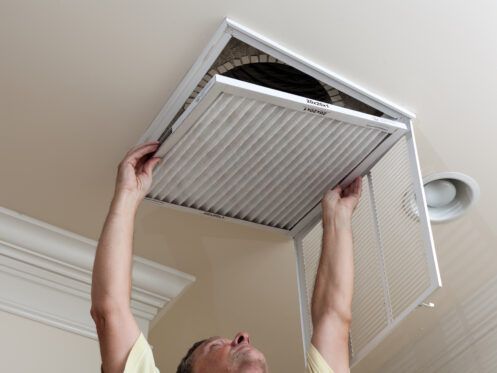Almost every air filter sold at your local Gilbert, AZ, home improvement store will have a MERV rating on it. MERV stands for minimum efficiency reporting value. What is significant about MERV is that it provides you with a measure of filtration effectiveness and airflow restriction in a single value.
History of the MERV Rating
The American Society of Heating, Refrigerating and Air-Conditioning Engineers (ASHRAE) developed the MERV scale in 1987. There were other rating systems used at the time, but none provided a fully accurate picture of the product. MERV did so while using a single, easily understandable number. The American National Standards Institute (ANSI) has since accredited the MERV scale. It has become an optimal standard not only in residential environments but in commercial ones as well. The EPA also recognizes MERV as the standard and uses it as a criterion in its evaluation of air cleaners.
Air Filters and the MERV Rating
There are two main factors to consider when evaluating an air filter: filter effectiveness and airflow. The MERV scale ranges from 1 to 20. At the low end of the range, airflow is high, but filter effectiveness is low. At the other end of the range, filter effectiveness is high, but airflow is greatly restricted. This scale is useful because it makes it easy to identify the right filter for a particular application.
Large Particulate Matter
When it comes to filter effectiveness, ASHRAE developed the MERV scale to gauge a filter’s ability to trap large particles. Large particulate matter measures between 0.3 and 10.0 microns in size. Often abbreviated PM10, these are the particles we associate with allergens. They’re also the particles that can cause problems in appliances as they accumulate and become coated in debris over time.
Fine Particulate Matter
Fine particulate matter refers to particles that measure 2.5 microns or less in size. Often abbreviated PM2.5, these are the particles we associate with air pollution. In fact, modern science has linked fine particulate matter to cardiovascular diseases, respiratory diseases, and cancer. While MERV does not measure PM2.5, that doesn’t mean that a product with a MERV rating doesn’t filter it. At MERV 16 and higher, filters do trap PM2.5. You’ll just generally need a different rating system to evaluate effectiveness.
MERV Rating 1-6
At MERV 1-4, a filter will remove less than 20% of all PM10. That effectiveness increases to 20% at MERV 5 and 35% at MERV 6. Filters in this category will trap:
- Pollen
- Mold spores
- Household dust
- Cockroach debris
- Dust mites and eggs
- Textile and carpet fibers
MERV Rating 7-13
At MERV 8, a filter traps at least 70% of all PM10 and 20% of all PM2.5. At MERV 13, those efficiencies increase to 90% and 95%, respectively. The filter also has a much greater ability to trap particles in the 0.30- to 1.0-micron range. Air filters in this category will trap:
- Coal dust
- Lead dust
- Legionella
- Milled flour
- Welding fumes
- Humidifier dust
MERV Rating 14-20
At MERV 14-16, a filter will trap between 90% and 95% of all particulate matter. At MERV 16, that includes 95% of even the smallest particles. At MERV 17-20, these are the high-efficiency particulate air (HEPA) filters. They trap at least 99.97% of all particulates down to 0.3 microns in size. At the upper end of the range, you get into the medical-grade HEPA filters, which are quite expensive. They trap 99.995% of all particles down to 0.1 microns. Air filters in this category will trap:
- Carbon dust
- Sneeze nuclei
- Radon particulates
- Bacteria and viruses
- Microscopic allergens
- Most tobacco smoke and auto fumes
HVAC Filters and MERV Rating
All central HVAC systems have at least one supply vent that requires an HVAC filter. Larger homes may have two or more. The average household must replace these filters about once every three months. This is where most homeowners are going to deal with MERV ratings on a regular basis.
An HVAC filter protects your HVAC equipment and ductwork from dust and other particles. It also helps to preserve the quality of your indoor air. The industry recommendation is to use the most effective filter that your HVAC system supports. That is between MERV 8-13 in most cases. If you’re unsure, check with your local HVAC company.
At MERV 13, your HVAC filter will trap nearly all the allergens that pass through the vent. It’s important that you don’t use a higher MERV than your system supports. Doing so reduces the static air pressure of the air handler. That will reduce comfort levels in the home and increase your monthly energy costs. Over time, it can also lead to increased wear and tear and eventually motor failure.
Automotive Engine and Cabin Filters
Companies that manufacture air filters for automotive purposes use the MERV scale as well. If you purchase your own automotive filters, it’s important to select the right MERV. Most engines need an air filter rated for MERV 11 or higher, but note that there are other important factors. Those include style, dimensions, capacity, and dry versus wet. The typical cabin filter is MERV 8-13 just as with your HVAC system. There are similar concerns here too. Using a filter with too high a MERV can reduce comfort, decrease fuel efficiency, and increase wear and tear.
Air Purifier Filter Stages
Most portable and whole-house air purifiers have two mechanical stages: prefiltration and HEPA filtration. Prefilters are generally MERV 10 or 8 or even less, depending on the brand and model. Choosing too high a MERV will affect airflow through the system. For the primary mechanical filtration, most systems use HEPA. HEPA has a MERV rating of 16-20. That said, MERV is less useful in this regard. You’ll want to focus on the HEPA rating system for greater insight into filtration effectiveness.
MERV vs. MPR and FPR
MPR and FPR are proprietary alternatives to the MERV scale. Products that provide an MPR and/or FPR will usually provide MERV ratings as well. The 3M company developed the microparticle performance rating (MPR) to measure the ability to filter particles between 0.3 and 1.0 microns. Home Depot developed the filter performance rating (FPR) to factor in filter lifespan as well. There is no simple conversion between the three. MERV 8-11 is like FPR 6-9 and MPR 600-1900. MERV 13 is like FPR 10 and MPR 2200-2800.
Your Indoor Air Quality Experts in Gilbert
A/C & Plumbing Doctors serves Gilbert and Maricopa counties and the surrounding areas. Our HVAC technicians install, maintain, and repair furnaces, air conditioners, heat pumps, and ductless mini-splits. We also install ductwork, ventilation, air purifiers, dehumidifiers, and humidifiers. Our plumbers specialize in leak detection, drain cleaning, and water and gas pipe replacement. You can also count on us to install fixtures, garbage disposals, tank and tankless water heaters, and water treatment equipment. Call A/C & Plumbing Doctors today to learn more about these products and services or to schedule an appointment.





